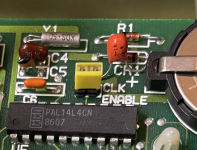fdiskitup
Experienced Member
So here's what I'm getting, all pins with the yellow jumper installed.
1 = H ------- 16 = H
2 = H ------- 15 = Squark ! (internal oscillator)
3 = H ------- 14 = Squark ! (internal oscillator)
4 = H ------- 13 = H
5 = H ------- 12 = L
6 = H ------- 11 = L
7 = H ------- 10 = 1HZ
8 = L ------- 09 = H

I also tried with the yellow jumper removed,
1 = H ------- 16 = H
2 = L ------- 15 = Squark ! (internal oscillator XT)
3 = L ------- 14 = Squark ! (internal oscillator XT)
4 = L ------- 13 = H
5 = L ------- 12 = H
6 = L ------- 11 = H
7 = H ------- 10 = 1HZ
8 = L ------- 09 = L
is my probe/ear not fast enough to catch the pulse ?
I'm using the "mem" setting on the logic probe to try and catch a pulse as a light.
The only ports doing anything vaguely interesting (not reading 255) are port 888(378h), 976(3D0h) and 1024 (400h) which appears to be counting up 0 to 255, repeatedly.
1 = H ------- 16 = H
2 = H ------- 15 = Squark ! (internal oscillator)
3 = H ------- 14 = Squark ! (internal oscillator)
4 = H ------- 13 = H
5 = H ------- 12 = L
6 = H ------- 11 = L
7 = H ------- 10 = 1HZ
8 = L ------- 09 = H

I also tried with the yellow jumper removed,
1 = H ------- 16 = H
2 = L ------- 15 = Squark ! (internal oscillator XT)
3 = L ------- 14 = Squark ! (internal oscillator XT)
4 = L ------- 13 = H
5 = L ------- 12 = H
6 = L ------- 11 = H
7 = H ------- 10 = 1HZ
8 = L ------- 09 = L
is my probe/ear not fast enough to catch the pulse ?
I'm using the "mem" setting on the logic probe to try and catch a pulse as a light.
The only ports doing anything vaguely interesting (not reading 255) are port 888(378h), 976(3D0h) and 1024 (400h) which appears to be counting up 0 to 255, repeatedly.


